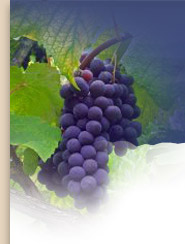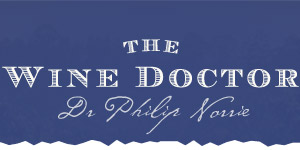Who imported the first documented Shiraz Vines into Australia
This seems a very basic question that should have been answered many, many years ago for Australia's iconic red grape variety; but until now no one had got the answer right. This article will tell how I solved the mystery.
Prior to its spread to the new world wine countries of Australia mainly, as well as South Africa, USA, Chile and Argentina; Shiraz or Syrah as it is spelt in the old world wine countries had its home mainly in the Rhone Valley in eastern France, around the town of Hermitage. It was always thought it was introduced there from its home in Persia (today's Iran), most liked by the Romans, but it could also have been introduced by the Greeks or Phoenicians after they established their colony of Marseilles (Massilia) around 600 B.C. depending upon which theory you prefer. The latest theory though, based on new DNA research, is that it is indigenous, being descended from the local wild Rhone vitis allobrogica vine family. Other old world countries which also grow shiraz, but to a much lesser extent and only recently, are Switzerland (around the village of Chamoson in the upper Rhone valley), Spain (around Toledo), Italy (in Tuscany) and Corsica.
Over the years in Australia shiraz has been taken for granted (along with grenache), so much so that many good mature vines have been removed in various vine pull programmes over the years, where people thought there were too many vines. But recently, the world and especially Asians and Americans have fallen in love with Australia's favourite red wine, so that now Australians are once more appreciating our iconic red. So what better time than now to get its history in Australia correct?
Even though it is grown all over Australia, the two best known homes for shiraz in Australia are the Barossa Valley in South Australia, home of Penfolds Grange and the Hunter Valley in New South Wales, famous for its Wyndham Estate Shiraz.
There have been several claims to being the first to introduce shiraz into Australia. Francois de Castella (a forebearer of today's famous marathon runner Robert de Castella) in his report - "The Grapes of South Australia. Reports to Phylloxera Board. A survey of the Viticultural Industry l94l-42" gave the honour to Alexander Riley of London who shipped red hermitage out to Sydney in 1830 based on James Busby's 1830 book. "Mr. Alexander Riley of London has also sent to the colony, the Panse, a raisin grape, which is cultivated in the south of France - a variety of muscatel from Marseilles, and the white and red Hermitage grapes - These were very lately brought out by Mr. Dutton, in the "Lady Blackwood".
The other possible introduction was from James Busby's collection of 1832 which arrived in Sydney on board the "Camden" in January 1833. James Busby is regarded as the father of the Australian wine industry. Firstly because he wrote four famous books on wine in the early days of the colony, namely; "Treatise on the Culture of the Vine and the art of Making Wine" in 1825, "A Manual of Plain Directions for Planting and Cultivating Vineyards and for making wine in New South Wales" in 1830, "Journal of a Tour Through Some of the Vineyards of Spain and France" in 1833 and "Journal of a Recent Visit to the Principal Vineyards of Spain and France" in 1834. Secondly because he established two vineyards - one at the Mate Orphanage at Cabramatta Sydney in 1825 and the other at "Kirkton" on the Hunter River near Belford after 1825 and thirdly because of this large collection of vines brought out to the colony. Between September 1831 and December l83l Busby did his famous tour of Spain and France and collected two cuttings of each of 437 varieties from the Montpellier Botanical Gardens in the south of France and 133 varieties from the Luxembourg Gardens in Paris. Busby placed the entire collection (built at his own expense and initiative) at the disposal of His Majesty's Government. "It is my wish to place this collection of vines at the disposal of His Majesty's Government, for the purpose, should it be deemed expedient, of forming an experimental garden at Sydney, to prove their different qualities, and propagate, for general distribution, those which may appear most suitable to the climate". Busby also made a separate collection of vines for his own private use. "As independently of the above, I have secured a competent quantity of all the most valuable varieties which I found cultivated in the best wine districts of France and Spain, both for wine and raisin". "If the following catalogue of vines (at the end of the Tour book = Catalogue First) amounting to 75 varieties (note only 74 varieties listed), 52 were actually collected from the vineyards I myself visited in the various provinces of France through which my route lay". Busby collected 10 to 20 cuttings of each of the above varieties.
Other introductions in the other colonies outside NSW, included Edward Henty in Portland Victoria in 1834 (subsequently failed). Waters in the Swan Valley in Western Australia also in 1834 and Barton Hack in Adelaide in South Australia in 1837. But all the action in the early days of the Australian wine industry was centred on the vineyards of Sydney and the Hunter Valley because viticulture began in Sydney in 1788 and the Hunter Valley in 1825 long before Western Australia in 1829, Victoria in 1834, South Australia in 1837 and Queensland after 1824 but mainly after 1848.
Before revealing the answer to the mystery of who was the first to import Shiraz vines into Australia, we should consider how the vines were kept alive for the 6 to 8 month voyage out to Australia. Vines were kept alive in one of four ways. Firstly little hot houses were used on the top deck but they proved unsuccessful due to being prone to damage during storms. So other methods had to be devised, such as sealing each end of the vine cutting in wax or inserting the vine cutting into a potato - by the end of the voyage you had a sick potato but a healthy vine cutting . The fourth and last technique used was to tie vine cuttings into bundles and then store them in barrels full of moist straw or mulch. The last three techniques also meant that the vine cuttings could be stored safely below deck.
I have always advocated that the title of the Father of the Australian Wine Industry should go to John Macarthur, also Father of our Sheep Industry and not James Busby; because Macarthur established Australia's second privately owned vineyard at his property "Elizabeth Farm" at Parramatta in 1793, made the first major importation of vines into Australia from France in 1817 after the fall of Napoleon in 1815 and established a vineyard and vine nursery on the Nepean River near Penrith in 1820. But his most important contribution to the Australian wine industry was the vine nursery and vineyard he established at his main property "Camden Park" at Camden to the south west of Sydney. This nursery began with experimental plantings in 1807 but really took off after the 1817 vine importation from France, where the vines were propagated and distributed throughout the colony, thus providing the major source for vine root stock in the early days of the colony, long before Busby.
The first vines to come to Australia were collected by Governor Phillip on his way out to Botany Bay with the First Fleet in 1787. He picked up vines from Rio de Janeiro and Capetown which would have been Portuguese varieties and Constantia respectively. The French Revolution began in 1789 followed by the Napoleonic era; so vine gathering expeditions by Englishmen in France and Europe, as was common later on the 1800's, was not possible until after the fall of Napoleon in 1815.
The first to do this was John Macarthur and his sons James and William. John Macarthur recognised the opportunity that presented itself to anyone with the vision to see that Australia could be the supplier of both wool and wine to England, now that both were unavailable due to the French blockade during the Napoleonic wars and the subsequent confusion in the past Napoleonic era. That is why the Colonial Secretary, Lord Camden (the town of Camden was named after him) ordered Governor King to grant Macarthur the unheard of grant of "not less that 5,000 acres" in 1803 which Macarthur named "Camden Park" in honour of Lord Camden.
Macarthur went to England to give evidence on behalf of Colonel Johnston (who had established a vineyard at Annandale in inner Sydney) who had led the Rum Rebellion against Governor William Blight (of Mutiny of the Bounty fame) in 1808. Macarthur was subsequently banned from returning to New South Wales so that he could not be involved in colonial politics, as a punishment. So Macarthur eventually took his two sons on a tour of European vineyards, now possible after the fall of Napoleon. After discussions with the colonial Office in early 1817 Macarthur was given permission to return to New South Wales on condition that he would not become involved in public affairs. So the vines collected accompanied the Macarthur men on their return voyage on board the "Lord Eldon" which arrived in Sydney in October 1817.
To me it was always logical that the first documented importation of Shiraz into Australia should be amongst these vines. So to test my theory I went through the Macarthur Collection of papers held in the Mitchell Library (the colonial history part of the Library of New South Wales in Sydney). Under the papers listed as "Horticultural Correspondence and Lists of Plants 1817-1873" is the "List of the plants remaining alive, on board the Lord Eldon".
The first plants mentioned were headed "Vines" and in this list was Syracuse and also Hermitage - both old names for Shiraz. (I don't know why both names appeared, sixth and eleventh respectively on the List). So my theory was correct and the mystery solved. The Macarthurs had the first documented importation of Shiraz into Australia. They then propagated these vines in their nurseries at Penrith and Camden Park and then distributed them throughout the colony of NSW.
In 1844 Sir William Macarthur (he had been knighted by then) under the pen name of Maro, wrote a book "Letters on the Culture of the Vine" where he talks about this collection. "In October 1817 a great part of the collection we had with us landed alive at Sydney and in the course of time throve". So cuttings would have been available to distribute to other colonist's vineyards where presumably they would have continued to thrive. He then goes on to say "But after several years careful cultivation, the only sorts which we obtained were those known as Gouais (La Folle) Muscat Noir (black muscat), Black Hamburgh, Little Black Cluster (Pinot Noir) Miller's Burgundy (Pinot Meuniere) and Sweet Water (a table grape)". So later some varieties, including the shiraz, did not fair so well in the Macarthur vineyards; but by this time they had become established in other Sydney vineyards to provide cuttings for others to barter for or buy.
The next question is - who took advantage of this shiraz to plant the first commercial shiraz vineyard in NSW, hence Australia? This person was George Wyndham who started planting his vineyard at his property "Dalwood" in 1831. Prior to this, vineyards were small and for personal use and this 1830 beginning makes the Wyndham Estate brand the oldest major wine brand/label in Australia. George Wyndham and his wife Margaret arrived in Sydney the day after Christmas 1827. They had travelled throughout Europe and Canada but decided to migrate to Australia instead. After seeing what was available in Tasmania they settled for some land next to the Hunter River near Branxton in the lower Hunter Valley in 1828. They lived in a slab hut by the river whilst their house "Dalwood" was being built to resemble his family's English home called "Dinton".
George Wyndham wrote a diary from 1830 to 1840 during the period he built Dalwood and established his vineyard. This diary is also available in the Mitchell Library and shows that George Wyndham obtained vine cuttings from a wide range of early colonists, who would have obtained their original vines directly or indirectly from this original 1817 Macarthur material. (Note Busby's vines did not arrive into Sydney until 1833 and would have needed a few seasons of propagation before enough were available for distribution).
The list of Wyndham associates who gave vines includes local farmers from the Hunter Valley such as George Townshend of "Trevallyn", James Busby and later William Kelman from "Kirkton", Dr. James Mitchell (father of David Scott Mitchell who founded the Mitchell Library collection) of "Stockton" and Captain Pike of "Pickering"; as well as colonists from Sydney such as Gregory Blaxland (who along with Wentworth and Lawson crossed the Blue Mountains in 1813 and thus opened up the interior of NSW) of "Brush Farm", Reverend Samuel Marsden of "Mamre", Robert Campbell of "Mona Vale", George Macleay of "Elizabeth House" and Captain Samuel Wright of "Parramatta". All these people are mentioned in George Wyndham's diary along with some lists of the vines obtained from them.
Other names for Shiraz include:
- Scyras, Circas, Schiras, Sirrah, Sirac, Syracuse, Syra
- Red Hermitage
- Petite Syrah
- Serine
- Candive
- In France - Antourenein Noir, Entournerein, Serene, Serenne, Sereine, Hignin Noir, Marsanne Noir
- In Argentina - Balsamina
George Wyndham is also famous for being the first to introduce Poll Hereford cattle into Australia. Today their descendants form the backbone of the Australian beef industry. So here we have a story involving the pioneers of sheep, shiraz and cattle in Australia.
Dr. Norrie is a direct descendent of Alexander Norrie from Scotland who settled "Commodore Farm" at Gresford in the lower Hunter valley in 1839, hence was a contemporary of George Wyndham.
Dr Philip NORRIE
MBBS,MA,MSc,MSocSc[Hons],PhD,MD, currently doing M.Phil

























